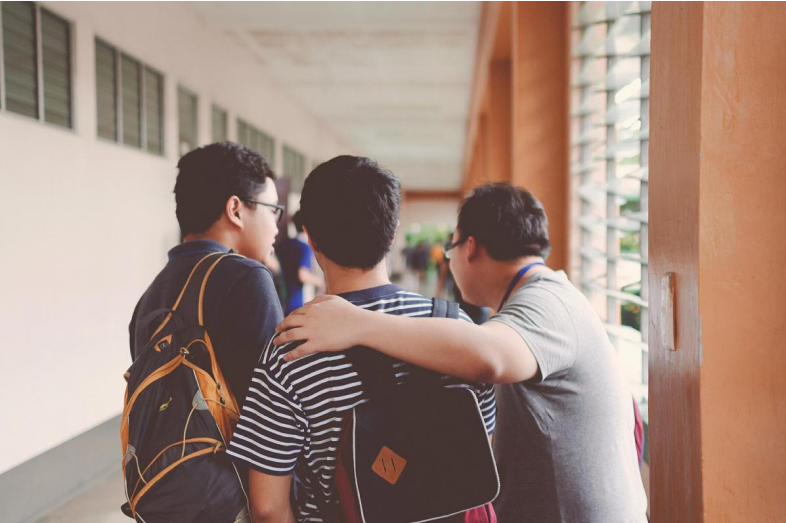
Want Safer Schools? It Takes Human Capital.
Counselors, school resource officers, educators play key roles, experts say

Counselors, school resource officers, educators play key roles, experts say
During an assembly at the high school where she was principal, Liz Dozier once asked 1,000-plus students if they knew someone who had been shot.
Every single student raised a hand.
“When I first got to the school, I didn’t understand all the effects of trauma — I just knew that our school was in crisis,” Dozier said. “The whole ecosystem that we had set up around kids was dysfunctional.”
Dozier, who served as the principal of Christian Fenger Academy High School on Chicago’s South Side for six years, was one of four panelists who spoke about the people who aim to make schools a safer place. The panel was part of the Education Writers Association 2019 National Seminar in May in Baltimore.
Dozier said she focused on identifying students in need and creating “care teams” made up of faculty and staff members students could trust. And she pointed to improvements over time, including raising the graduation rate from 40 percent to 80 percent, lowering the number of arrests each year from 300 to less than 10, and reducing the dropout rate from 20 percent to less than 2 percent.
Addressing trauma and mental health issues is becoming part of the job description for many people who work in a school, even if they’re not a counselor, Dozier said.
The dual roles of every employee — and especially those of school resource officers and counselors — were the focus of the EWA panel, moderated by The Los Angeles Times’ Sonali Kohli.
Panelist Akil Hamm, the chief of police for Baltimore City Public Schools, shared his perspective on how the obligations of his school resource officers (SROs), who are unarmed, have shifted in recent years as they’ve tried to change their approach.
They’re no longer reprimanding kids for lingering in the hallways or enforcing the school’s dress code, he said, though SROs are present to make arrests when necessary. But a big part of an SRO’s job in Baltimore is to be a positive male role model, Hamm said.
Some are assigned to the high schools they graduated from; others become coaches or mentors at their school. Rather than reacting to outbursts and misbehavior, Hamm said that mentoring and guiding students has proven more effective in keeping everyone calm, focused and safe.
“When you do that, kids come to us. They tell us, ‘Hey, so and so has a gun. There’s going to be a fight at this place, at this time. This person is posting stuff on social media,’” Hamm said. “When you have a relationship with kids and they trust you, they want to tell you.”
Trauma and mental health tend to be at the core of difficult situations with students, said panelist Amanda Fitzgerald, the director of public policy for the American School Counselors Association.
The duty to help students shouldn’t (and frankly can’t) fall solely on school counselors and social workers alone, Fitzgerald said. Ratios in schools are much higher than they should be — the recommended counselor-to-student ratio is about 1 to 250, but it’s more likely to be a ratio closer to 1 to 500, she said.
That said, the role of social workers and counselors in elementary schools is critical. Social and emotional learning skills — like how to cope with grief and anxiety, how to be a good friend, how to behave in a classroom setting, how to manage stress and anxiety, and how to talk to a trusted adult — are vital coping mechanisms that can prevent acts of violence as a child becomes an adolescent.
“High schools aren’t the problem,” said Fitzgerald. “It’s our elementary schools. They’re just not employing enough school counselors.” She added: “If there is not someone there trained in the building that can identify issues and provide early intervention or prevention methods, then we see people slip through the cracks.”
Toward the end of the session, an audience member asked why the topic of gun control hadn’t been discussed. Panelist David Osher, a vice president and institute fellow at the American Institutes of Research, jumped in.
Schools can’t control a student’s ability to access a gun at home or off campus, Osher said. What administrators can do is prioritize staff relationships with students so that changes at home and in mood aren’t missed.
“You have to understand the culture of guns in our society,” Osher said. “If we really want to prevent shootings and other forms of violence, … what we need to do is” intensify social and emotional learning.
Having employees and resources in place for students to rely on is vital to maintaining a safe environment, Osher said. Students who are struggling with their mental health need to feel comfortable reaching out for help – or else they won’t at all.
“If people do not feel safe identifying a need, they’re not going to ask for support for that need,” Osher said. “And then that need becomes a problem.”
The care team approach, Dozier said, worked at Christian Fenger Academy High School because it prioritized the students. When she first became the school’s principal, Dozier thought it would be easy to remove troublesome students from the classroom to solve the problems at Fenger.
But she quickly realized how wrong she was.
“I really thought I could suspend and expel my way into excellence,” Dozier said. “What it really boiled down to, for us, was addressing the extreme trauma that our young people were facing on any given day.”
Your post will be on the website shortly.
We will get back to you shortly